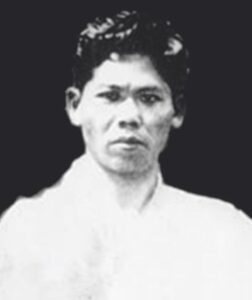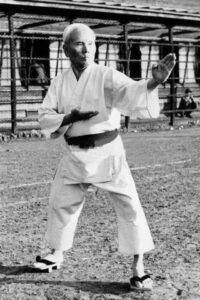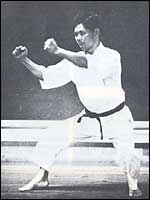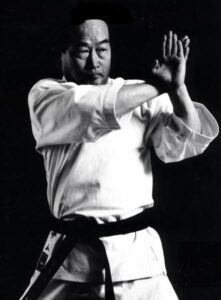
Yoshitaka “Gigo” Funakoshi was born in Okinawa in 1906. Already from childhood, he was diagnosed with tuberculosis, which was also the cause of his death in 1945. Yoshitaka began his formal training in Karate when he was 12 years old, as a means to improve his health.
At the age of 17, Yoshitaka traveled with his father Gichin Funakoshi to Tokyo. The task was to spread Karate in mainland Japan.
The change in Style

Over the years, the Okinawan interpretation of Karate changed from a self-defense fighting technique to a philosophical and mental way of Karate practicing. I will attribute that change to Gichin Funakoshi and maybe Kenwa Mabuni (Mabuni arrived in Japan in 1928), in connection with the introduction of Karate in mainland Japan. But the change did not stop there. Yoshitaka Funakoshi changed and developed a Karate style that definitively separated Japanese Karate-Do from the local Okinawan arts, it received a notoriously Japanese flavor. Those changes were probably made around 1930 and in the years thereafter.
The old techniques from To-de, Tomari-te, and Shuri-te emphasized the use and development of the upper body, open hand attacks, short distances, joint locks, basic grappling, pressure point striking, and use of the front kick and variations of it.
Yoshitaka introduced low stances and long-distance striking techniques, probably inspired by Kendo (way of the sword, a Japanese form of fencing with two-handed bamboo swords) and Iaido (the way of mental presence and immediate reaction). Yoshitaka also introduced new and higher kicks including Mawashi-geri, Yoko-geri, Ushiro-geri etc. Savate is often cited as the source of the kicks that Yoshitaka introduced into Karate. There are rumors that Yoshitaka is the person who invented stances such as Kokutsu-dachi and Kiba-dachi, but this is not true.
Yoshitaka Funakoshi did a lot of “magic” on his father’s Okinawan Karate. All the Kata were changed and modified to such an extent that it could no longer be said to be Okinawa Karate, but rather Japanese Karate-Do.
Modern fighting

Yoshitaka also laid the foundation for a modern form of prearranged fighting such as “Gohon Kumite”, a system very much like Kendo, an art that Yoshitaka also practiced and studied under the last Great Master, Hakudo Nakayama. Later on, he added, “Kihon Ippon Kumite”, “Jiyu ippon kumite” and “Jiyu kumite”.
The essence of Japanese Karate was now changed to a philosophical and mental way, “Karate-Do”, and the primary techniques were punching and kicking. By making all these changes, Japan got its very own unique style.
Yoshitaka diet at the age of 39 in the year 1945.
Yoshitaka Funakoshi.
The creator of modern Shotokan Karate-Do.
This is not the end!

The development of Karate-Do did not stop after Yoshitaka’s death. In 1949, Masatoshi Nakayama (a student of Yoshitaka and Gichin Funakoshi) and Isao Obata, as well as others, established the organization JKA (Japan Karate Association) with Nakayama as Chief instructor.
Working with Teruyuki Okazaki, Nakayama restructured, modified, and standardized Shotokan Karate. The intention was now to follow Japanese Karate-Do as well as new methods developed for sporting events.
Masatoshi Nakayama.
The creator of modern Shotokan sport Karate.
Thanks for reading.
Gert
